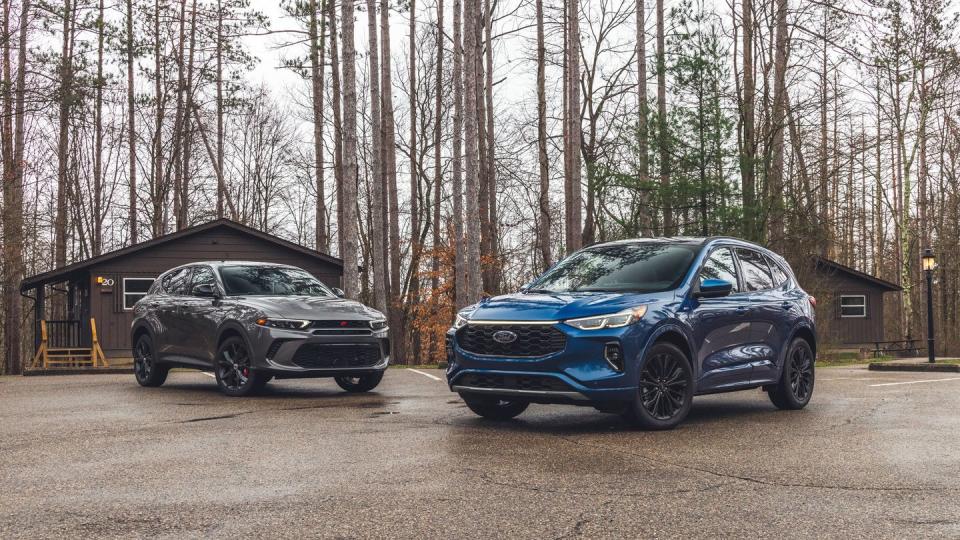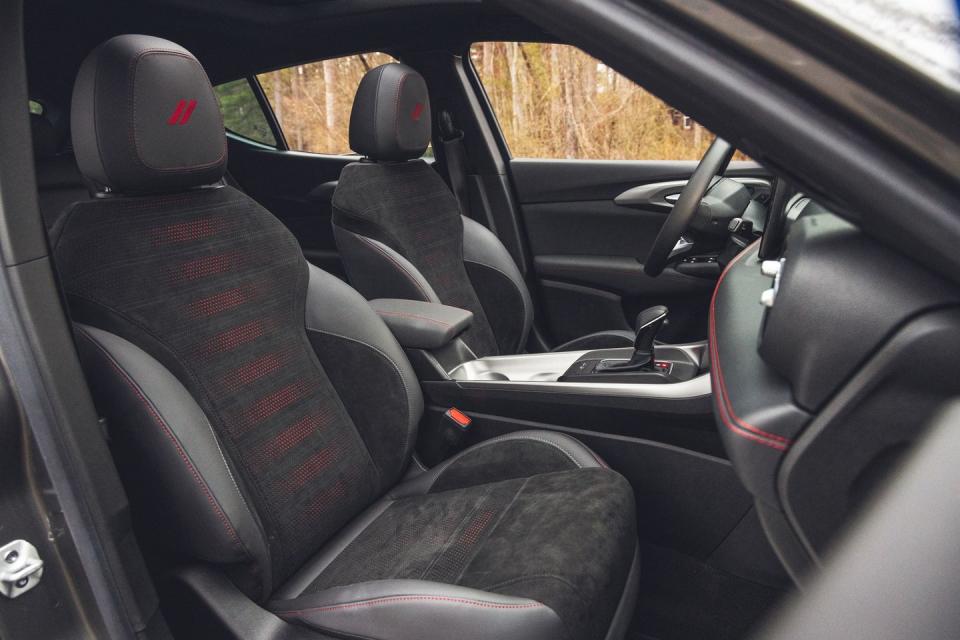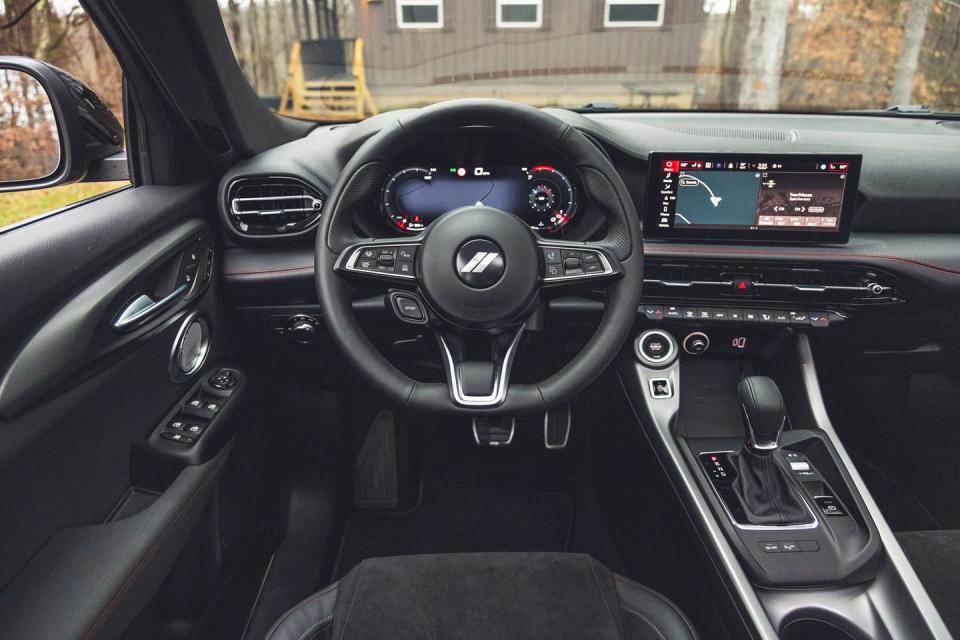Comparison Test: 2024 Dodge Hornet GT Plus vs. 2023 Ford Escape ST-Line Elite

The generation gap is alive and well in the compact-SUV segment. Take the Dodge Hornet and the Ford Escape: Both hit all the compact-crossover requisites: four doors, seating for five, all-wheel drive, turbocharged four-cylinder engine. But 23 years the senior and well into its fourth generation, the Escape is an elder statesman. The Ford's buttoned-down, respectable image and calmly capable virtues exist in stark contrast to the new-for-2023 Hornet, which displays all the nervous energy and bravado you'd expect from a brand known more for the pathological hawking of horsepower than for providing sensible, efficient family transportation—and we mean that in the best way possible.
Our Ford Escape ST-Line Elite would sticker at $43,355 as tested (based on 2024 pricing); skip the sunroof, the Premium Technology package, and a few minor items, and you're at $39,455. The top step in the three-rung ST subline (ST-Line, ST-Line Select, and ST-Line Elite), it sits above the base Active trim ($30,990 for the front-wheel-drive version and $33,160 for all-wheel drive for 2024) and up near the Platinum ($38,610 FWD and $40,110 AWD) but below the front-wheel-drive-only plug-in hybrid ($41,995). The ST-Line Elite treatment includes the usual bits such as a unique mesh grille and rear "skid plate," a larger rear spoiler, 19-inch wheels, and a monochromatic exterior treatment; ours was rendered in a coat of Atlas Blue Metallic paint that perfectly complements its refreshed-for-2023 exterior. Interior touches include a flat-bottom steering wheel with red stitching, the latter extending to the doors, seats, center armrest, and floor mats. It's not a bad place to spend time, but the vibe is undeniably understated.

The GT Plus Dodge Hornet is similarly positioned and was priced at $44,725, with $6730 of options. The GT Plus sits above the base Hornet GT ($32,995) but below the Hornet's plug-in-hybrid variants, which start at $42,995. Ours arrived finished in an attractive Gray Cray paint ($495) and equipped with the GT Blacktop and Track Pack bundle ($3990) and Tech Pack Plus ($2245). That means gloss-black mirror caps and window moldings, dark "Hornet" and "GT" badging, 20-inch wheels, and red brake calipers. Black faux-leather eight-way-adjustable sport seats with red accents, a leather-wrapped steering wheel and bright-finish pedals highlight the interior. Cosmetically speaking, it's a lively and style-rich effort inside and out.
The pair find some common ground in engine displacement, with both using a turbocharged 2.0-liter four-cylinder. The Escape is good for 250 horsepower and 280 pound-feet of torque, while the Hornet has a touch more muscle at 268 ponies and 295 pound-feet; both deliver full torque at 3000 rpm. In addition to packing slightly more power, the Hornet has a nine-speed automatic transmission, while the Escape has an eight-speed. Though their powertrains appear similar on paper, our testing revealed distinctly different personalities.

2nd Place: Dodge Hornet
The Hornet is a bit of an outlier in this segment, its Alfa Romeo DNA imparting a lively and sporty disposition that the Dodge logo doesn't try to hide. Though its profile and marketing materials say "compact crossover," its personality is more hot hatch than family hauler. It's not surprising when you consider the Hornet is assembled alongside the Alfa Romeo Tonale in Italy and shares with its continental cousin, among other items, its suspension, dampers, and all-wheel-drive system. (The Jeep Compass is built on the same platform, so you know where to look for a ruggedly styled albeit less speedy alternative with a significantly lower MSRP.)
HIGHS: Youthful attitude and styling, quick reflexes, supportive sport seats.
LOWS: Limited passenger volume, personality has no "off" switch, overly firm ride.
VERDICT: With edgy style and the manners to match, the Hornet loves to romp, but its firm ride and aggressive throttle tip-in never take a break.
Though its elevated ride height helps the Hornet identify as a crossover, it looks a little forced, given its otherwise youthful and mildly aggressive appearance. Its dynamics reinforce that overt sportiness with a stiff suspension tune fond of communicating the details of every pothole, accurate but artificial and overly flinty steering in any setting, and aggressive throttle tip-in with a hint of torque steer that arrives quickly enough to surprise not only the driver but also the vehicle's traction-control system. Dodge has a performance reputation to maintain, and we get that—hammering this on a track would be fun. But our crew of C/D staffers opined in near unison that we would trade a bit of its edginess for a more linear and refined response in nearly every metric. As one editor noted, "It's still a tall crossover, and the red brake calipers can't do anything to change that." Those calipers also can't imbue the Hornet with class-leading braking, as it required 177 feet to stop from 70 mph, 11 feet more than the Escape.

Refinement aside, the Hornet's 5.7-second 60-mph time bests the Escape by one-tenth of a second. However, the Dodge's 14.5-second quarter-mile time trails the Ford's by a tenth, so it's a wash. The Hornet returned a decent 25 mpg over our 600-mile test route, but the Escape topped that with 28 mpg. The Hornet improved slightly on our 75-mph highway fuel economy test with a figure of 28 mpg. With a 13.5-gallon fuel-tank capacity, the Hornet can cover 370 highway miles between fill-ups.
Objectively, the Hornet's 103.8-inch wheelbase and 178.3-inch overall length translate into a cabin that's among the coziest in the compact-crossover segment. The cargo room also reflects its small footprint, with just 27 cubic feet behind the rear seats and 55 with them folded, measurements that trail the Escape by 11 and 10 cubic feet, respectively.
Interior comfort is notable, and the sport seats received almost universal praise for comfort and support with the caveat that larger folks may feel a bit pinched. Headroom is limited. The 10.3-inch infotainment screen looks thoroughly modern, and the images are high resolution, but the software sometimes needs to catch its breath after several rapid-fire inputs. The screen, dash, and console are angled toward the pilot in the snug, driver-focused cabin. Anomalies worth mentioning are the turn-indicator stalk's distant position in relation to the wheel and the confounding logic of the rear-wiper control.

1st Place: Ford Escape
We've established what the Escape isn't: flashy, extroverted, or new. But it carries a big stick, metaphorically speaking, in the form of its 250-hp turbocharged 2.0-liter four-cylinder engine. Yes, the Ford's four-pot is slightly enervated compared with the 268-hp Hornet's, but it's clearly superior in terms of comportment and linear response. Its torque, 280 pound-feet, falls a bit shy of the Hornet's 295, but again, the Escape's power delivery is so drama-free that we'll gladly trade a lower spec-sheet number for improved refinement.
HIGHS: Speedy, linear power delivery, impressive highway fuel economy and range.
LOWS: Acres of cheap-feeling black plastic inside, front seat bases are a little short, unsupportive backrests.
VERDICT: Quick, practical, and versatile, but free of frills and short on personality.
Just as its styling is low-key, so too is the Escape's dynamic modus operandi. At 1.9 seconds to 30 mph and 15.2 to 100 mph, it's 0.2 and 0.9 second quicker, respectively, than the Hornet. Yet the Ford just digs in and gets the job without a hint of torque steer, or an extroverted exhaust note to draw attention to itself. True, the Hornet has a bit more grip (0.85 g on our 300-foot skidpad), but it wears 20-inch ZR-rated Michelin Pilot Sport All Season 4 tires; the Escape rolls on slightly skinnier 19-inch Bridgestone Ecopia rubber and posted just 0.82 g. And while it takes a genuinely seasoned derrière to ascertain a difference of 0.03 g, nearly every tester commented on the Escape's superior ride quality—a worthy trade-off. Plus, the Escape's 71-decibel interior noise level at 70 mph registers two decibels quieter than the Hornet's din, making the Escape a more pleasant environment for highway travel.

C/D staffers agreed that neither the steering nor the brakes lived up to the engine's promise, with one tester referring to the handling as "lazy," while most agreed the brakes were a bit grabby. Still, one driver noted that the Escape was "surprisingly fun" and that Ford could "almost get away with calling it a true ST with a more aggressive wheel-and-tire setup." Pushed hard through the winding roads of Ohio's Hocking Hills region, it delivered more precision and usable grip than nearly every driver anticipated.
Crucially, the Escape takes the trophy in numerous metrics critical to the compact-crossover class. Compared with the Hornet, it provides more overall interior volume (104 cubic feet versus 98), more headroom (40.0 inches front and 39.3 rear versus 38.8 and 38.2, respectively), better outward visibility, and a far more comfortable and usable rear seat with nearly three additional inches of legroom.
While the Escape is dynamically fit for its age, its basic-black pebble-grain interior looks like it hasn't been updated since Kanye West bumrushed Taylor Swift at the VMAs. The Hornet uses similar materials but infuses plenty of style, accents, and shapes to give it a more contemporary feel. The Escape's infotainment system follows the fundamental blueprint; it lacks any gee-whiz gimmickry, but the 13.2-inch touchscreen's home view can simultaneously display a map, an audio source, and another app. It's a shame Ford couldn't authorize the expenditure to place a physical control for the drive modes near the shifter, but at least they are only one button input away from the home screen. A row of climate commands permanently resides along the bottom of the screen.

Helping to swing the pendulum in the Escape's favor is the 28-mpg fuel-economy number it posted on our 600-mile trip. Furthermore, the Escape returned 32 mpg in our 75-mph highway fuel-economy test. Those results best the Hornet's by 3 and 4 mpg, respectively. With its 15.7-gallon gas tank, the Ford has an impressive highway range of just over 500 miles.
In the compact-crossover segment, utility and versatility, rather than flash and razor-sharp handling, appeal to most buyers. Here at C/D, we'll take performance where we can get it. But in this matchup, the Escape manages to meet or beat the Hornet in nearly every metric for a similar price. It just hides that capability behind a mature personality and demure wardrobe.
You Might Also Like

 Yahoo Autos
Yahoo Autos 